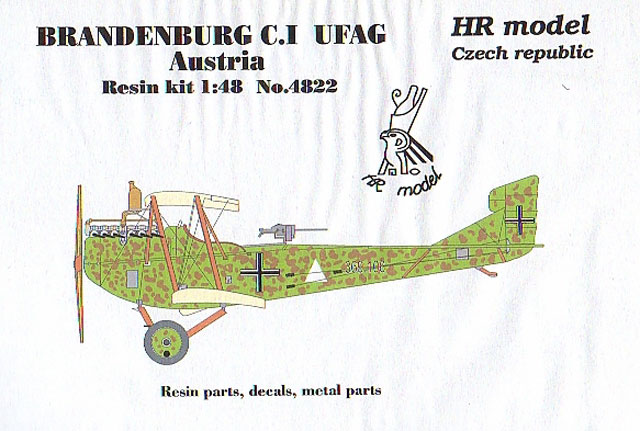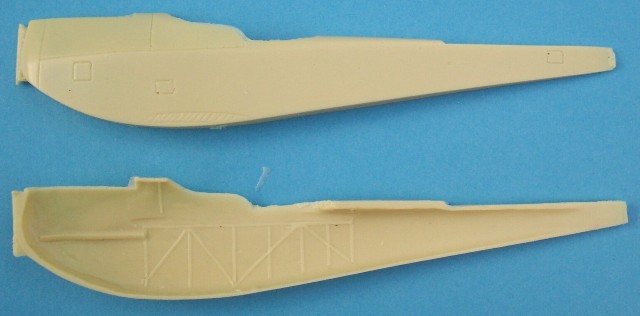|
Brandenburg C.I (UFAG)

HR Model,
1/48
scale
S
u m m a r y
|
| Catalogue Number: |
HR model Brandenburg C.I (UFAG)
Resin kit 1/48 scale No.4822 |
| Scale: |
1/48 |
| Contents and Media: |
Over 40 parts in cream coloured
resin; 1 photo-etched fret; printed acetate instruments |
| Price: |
693,30 Kč (approx. USD$31.00) available online from hobbyshop.cz |
| Review Type: |
FirstLook |
| Advantages: |
Well formed resin pieces, decals in
perfect register, useful p-e and acetate sheets, subject is a
two-seater. |
| Disadvantages: |
A little tweaking needed in some
areas. |
| Recommendation: |
Recommended for experienced
modellers |
Reviewed by
Rob Baumgartner

HyperScale is proudly supported by Squadron.com
It is always good to see two-seaters make an appearance on the modelling
scene.
The Hansa Brandenburg CI played an important role with the
Austro-Hungarian Air service. It was reliable and tough, which made it
an excellent choice as an armed reconnaissance aircraft. With over 1200
being built, it became the Duel Monarchy’s most numerous type to see
service.
The kit is presented in a sturdy box with the contents being sealed in
separate plastic bags. There are over 40 resin parts along with a fret
of photo etched metal, a printed piece of acetate and a single decal
sheet.

Click the thumbnails below to view larger images:
The larger resin items are cast separately with the smaller elements
being contained in a “wafer” of flash. This doesn’t present any problems
and cleanup is a breeze.
The fuselage halves are moulded with some representative interior
structure which modellers may wish to augment with plastic card. Both
pilot and observer occupied a large opening in this aircraft so
enhancement of the cockpit area is mandatory.
As only a couple of seats and a control column are provided, there is
plenty of scope for the detailer. Modellers may consider inserting the
partition separating the two “offices”, adding fuel tanks, a writing
board, map pocket, air pump, compass, and fuel gauge…just to name a few
improvements.
A nice set of general arrangement drawings come with the kit and these
generally match the contents of the box. Additional help can be gleaned
from a set of plans done by Colin Owers. They appeared in 2005 and were
published in the Albatros Productions “Datafile” on the subject.
The main wings consist of four pieces and pinning is recommended for a
secure bond to the fuselage. All trailing edges were sharp with no
evidence of distortion. Careful inspection did reveal a few small air
bubbles and these were located on the leading edge adjacent to the
casting blocks. Some filling will be necessary but shouldn’t present any
problems.
The upper wings match HR’s own supplied drawings very well. Comparison
of the lower wings is a different affair however. Here we find that the
rib tapes don’t match the kit’s included plans at all, although they do
match those in the “Datafile” quite closely.
Rib detail on these flying surfaces is quite subtle with strips being
used on both top and bottom surfaces to depict their location. Thus
modification of these items to suite your preferred set of diagrams will
not prove too hard.
Regarding the lower wings, the trailing edges will need their scallops
added. This is unusual considering that these have been accommodated for
with the upper wings. Again, this is not complicated surgery but will
require care.
One other point to note is that the location holes for the lower wing
outer struts need moving slightly. This will maintain their correct
angle, which was such a prominent feature of this design.
According to HR’s included plans, the fuselage is a little short. This
is not a major problem in the overall scheme of things and only the
fastidious would be concerned with it. The paperwork also shows that the
nose could do with a swipe with wet-dry paper to flatten the profile.
As expected, the struts and undercarriage are all in resin. Despite the
material used, they are very strong and very useable. Some of the
smaller items cast in this medium could be a little tricky to clean up
and it may be easier to scratch build them using the supplied parts as
templates.
A photo etched metal fret is supplied and this contains 15 parts. Among
the items included are the observer’s gun ring, propeller boss, foot
steps, radiator grills and an instrument panel. This latter piece
attaches to a printed acetate sheet which represents the dial faces.
Thoughtfully, the same material is used for the windscreen which is
easily attached using epoxy or wood glue.
The decals are superb. They were in perfect register and the carrier
film is commendably thin. Three subjects are catered for and offer a
wide variety of schemes so all skill levels are accommodated for.
The Hansa Brandenburg CI series is a complex one so choose your subject
aircraft carefully. There were many changes made along the way which
meant a myriad of detail variations.
HR has chosen to do the 369 series and gives the modeller a good
starting point. As the manufacturer themselves state, this is a product
aimed at advanced modellers. There are many enhancements that can be
made along the way and even a few refinements.
That not withstanding, a fine model can be built from the box and
patience will reward.
Recommended for experienced builders.
Thanks to
hobbyshop.cz for this review
sample.
HR Model kits are
available online from the hobbyshop.cz website
Review and Images Copyright © 2006 by Rob Baumgartner
Page Created 09 October, 2006
Last updated 21 February, 2007
Back to HyperScale Main Page
Back to Reviews Page
|
Home | What's
New | Features
| Gallery |
Reviews | Reference
| Forum
| Search